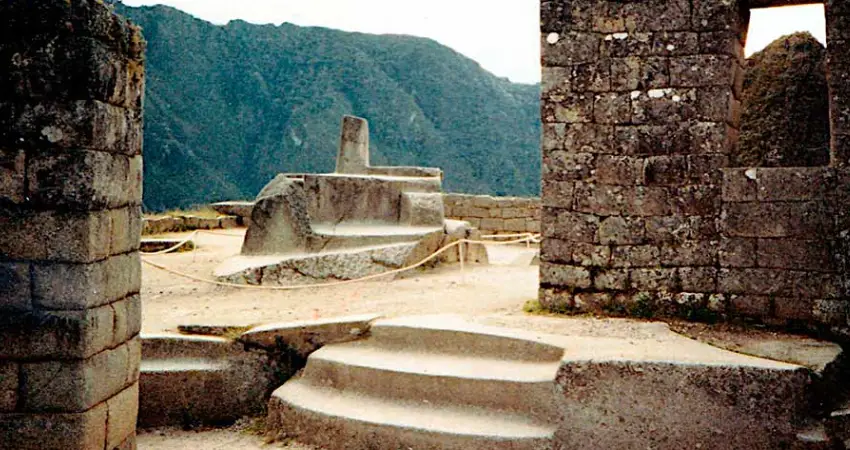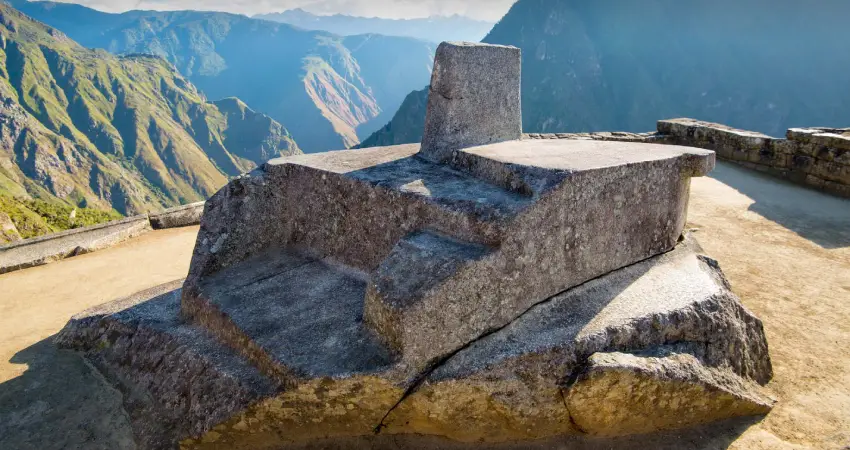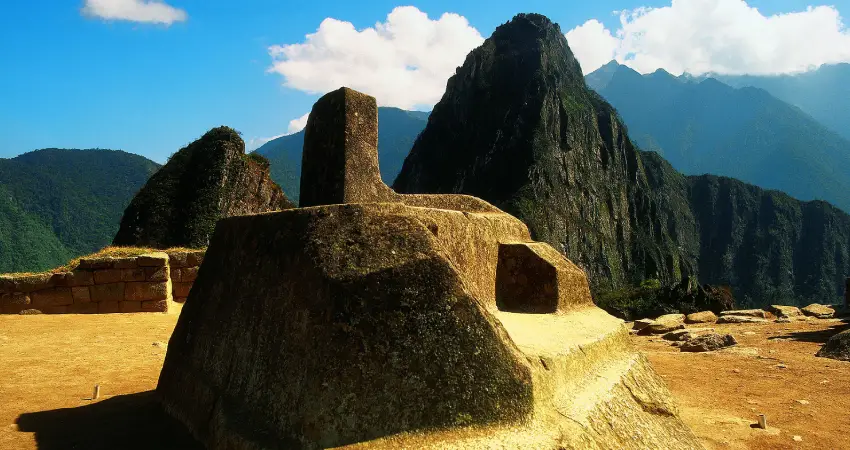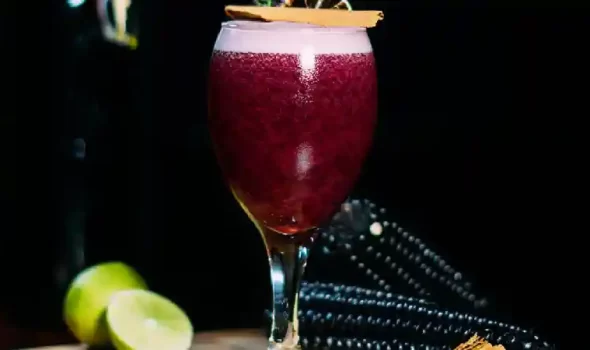
1.- INTRODUCTION TO INTIHUATANA
The Intihuatana Stone is considered as the most emblematic places within the citadel of Machu Picchu, in the Andean region of Peru is this ancient altar intended primarily as a sun worship that according to Andean tradition is considered as the main place where the sun is tied, made entirely of stone is located on a raised platform from where you can see an incredible view of the Inca citadel.
| “The best views come after the hardest climb.” |
The Intihuatana is located in the religious sector of the Inca citadel, in direction to the north of the main square, thanks to the incredible view that it has can be appreciated not only the citadel but also the surrounding areas, of course this is not a coincidence since the location it has is strategic on a rock of natural origin that gives a connection between the sky and the sun so it is known that is directly associated with the Machu Picchu astronomy. To be more specific it is located at 13°09′47″S latitude and 72°32′44″W longitude.
2.- Topographic features of the Intihuatana Stone
It is appreciated that the environment near the Intihuatana is a rugged and mountainous terrain that is quite characteristic of the Andean region. What characterizes the Intihuatana is that it is located on a platform of natural rocks leaving an incredible view of the Machu Picchu Mountain and the popular Huayna Picchu Mountain, it is also possible to see the citadel in a different way in which it integrates harmoniously with a natural environment in the same style of a living organism that blends with the space and geography of the Andes.
On the other hand the surrounding landscape is much more dramatic, you can see hillsides that are covered with vegetation typical of the place that is mostly tropical, you can also see how the valley is crossed from side to side by the beautiful Urubamba River. Although it has an altitude of 2300 meters above sea level you can easily feel a subtropical climate which in turn is a factor that contributes to the vegetation that surrounds both the citadel of Machu Picchu as well as the Intihuatana. This also affects the effects of nature in which the mornings are plagued by mist and sunny afternoons thus giving a unique beauty to the Intihuatana Stone worth visiting.

3.- What is the Intihuatana Stone?
The name Intihuatana comes from a Quechua word that was originally the language spoken by the Inca culture, in fact this language is part of the cultural legacy that exists in Peru as many people still practice its use.
- Inti represents the Sun,
- Wata means to tie
- Na is considered as a suffix used to determine a tool or place.
Combining everything results in the word Intihuatana which represents “the place where the sun is tied”.
4.- Main function of the Intihuatana Stone
Many researchers and scholars suggest that the Intihuatana had specifically a Machu Picchu astronomy function, thus it is believed that it served as a sundial, because the sun aligns directly with the Intihuatana on the 2 equinoxes that occur during the year without creating any shadow. This occurs because the Intihuatana Stone has a slight inclination of 13° which shows what was the level of knowledge in Machu Picchu astronomy.
It is also known that during the time of the Inca culture there were common religious ceremonies oriented essentially to the worship of the sun god and mainly on these dates which had a direct relationship with the harvest and prosperity. Even you can also see how in the temple of the sun shadows are projected during important events such as the winter solstice, time of year which also celebrates the popular festival of the sun in Cusco, known worldwide as Inti Raymi, while in the summer solstice is possible to see how at dawn there is a projection of shadows on the Intihuatana, thus creating a triangle where you can see two circles, although of course today it is almost impossible to understand what was the use of this have created many theories around it.
5.- Physical description and analysis of the structure
The Intihuatana is made entirely of granite rock and in the upper part forms a small elevated platform, incredibly the selected rock is organic and typical of the place for this reason was worked with great skill giving to understand the great ability that had the people who worked in the quarries during the Inca culture. The fine finish can be appreciated since the whole Intihuatana has a careful and fine polishing as well as being molded leaving us to see its rectangular shape but at the same time presenting curved edges and flat spaces which gives the interpretation that it had a ceremonial purpose.
Its base measures approximately 1.80 m long and 1.60 m wide, while protruding 60 cm high where you can see a central stone that has the appearance of a pillar which for many has been cataloged and called a stone table. This pillar in the center is what stands out and is known essentially for being directly associated with the sun and its movements. Thanks to the fact that the complete composition of the Intihuatana is made of granite, this entire sector is one of the best preserved with the passage of time since this element is extremely resistant and durable, which also lets us understand that the Inca culture had a great geological knowledge when choosing the main elements for the constructions and linked to the Andean cosmology we can also see its cosmological approach where the solidity and permanence of ceremonial centers is valued.
6.- METHODS OF USE OF THE INTIHUATANA
Essentially the Intihuatana was elaborated as a solar observatory, in this way the Incas could appreciate the movement of their main God and at the same time predict important events during the year, through meticulous observations considering the position of the sun in the sky and at the same time in the shadow that was projected on the pillar of the Intihuatana, the Andean priests could access much more precise data to know astronomical events of great importance that had a positive impact within the culture.
Observations of the shadows
Something that is still surprising today is that the pillar at the center of the Intihuatana is oriented in a way that the shadow varies during the day and also during the year, in fact during the equinoxes you can see how the sun does not create any shadow between the pillar and the stone, according to the Andean belief this event signals the change of the season so the interpretation of the Andean priest is that it is the exact moment to start with agricultural activities such as planting or harvesting, it is known that the absence of shadow during this time of year is considered as a moment of balance between day and night, having a great symbolic charge for the whole culture.
6.1.- Observations of the sun
The solstices occurring in December and June showed very specific directions. For example, during the winter solstice that occurs during the month of June, the shortest day of the year could be appreciated since the sun rose to a very low point in the sky, so the Andean priests knew that this represented the end of the agricultural cycle and at the same time the beginning of the next one, in this way the Incas could mark the seasons and determine the times of harvest and sowing.
6.2.- Positioning and orientation
Now we know that the alignment that has the Intihuatana is not something random, in fact it is quite the opposite because the Inca engineers embodied all their knowledge of geometry and Machu Picchu astronomy to be able to orient it at a very specific level of the horizon, in fact even its location is key to appreciate the sunrise sun and the same time at sunset in this way the annual cycle of the sun, the length of days and nights, the passage of the seasons could be determined.
7.- AN ANCESTRAL LEGACY OF INCA CULTURE
“Did you know that the main activity of the Inca culture was based on agriculture, in fact the domain they had over the weather events was so wide that it is believed that they could prevent them and somehow take advantage of them in order to have greater benefit in the crops. Today it is known that one of the instruments that helped in this knowledge was the Intihuatana.”
8.- FAQs ABOUT THE INTIHUATANA
- What exactly is Intihuatana?
The Intihuatana is a structure located in the Inca city of Machu Picchu is essentially used for ceremonies and astronomical purposes essentially for the sun, in fact the same name it has refers to the “Place where the sun is tied”, because thanks to the projection of shadows generated during various times of the year could predict certain events of nature.
- How did the Incas use the Intihuatana stone?
It is known that the Incas used the Intihuatana as an astronomical tool essentially to be able to track and determine the movements of the sun through the shadow that was created, its domain was so great that the Andean priests could determine key moments during the year as the cycle of beginning and end of agriculture as well as opportune moments to perform religious ceremonies.
- Why is Intihuatana considered significant in Machu Picchu?
It is considered one of the most important places within the city of Machu Picchu because it had a dual function, it is essentially of astronomical use to determine important times during the year and at the same time religious where you could worship the main god of the Inca culture, the sun.
- Can tourists touch or interact with the Intihuatana stone?
No, currently it is forbidden to touch the Intihuatana, because the historical value it possesses has made it is protected and preserved, I rigorously, thus ensuring that the wear that may have by physical contact is reduced zero and within the conservation policies of the Inca cities of Machu Picchu has also restricted access at certain times of the year so that there is not such a high concurrence.

Currently the Intihuatana is considered as one of the main places within the Inca citadel, however, its visit is also restricted as a form of preservation, to be able to visit it requires proper planning both in season and in schedules. Auri Peru can provide you with a unique and exclusive experience in which you will have enough time to get to know this relic within Inca city, contact us now and start designing your next adventure.
“Passport: Your ticket to endless stories.”





















